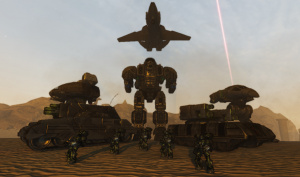Difference between revisions of "Combined Arms"
m |
m (nb) |
||
| Line 3: | Line 3: | ||
Though the lower-echelon units of a combined arms team may be of homogeneous types, a balanced mixture of such units are combined into an effective higher-echelon unit, whether formally in a table of organization or informally in an ad hoc solution to a battlefield problem. For example an armored division — the modern paragon of combined arms doctrine — consists of a mixture of infantry ([[Battle Armor]]), [[Mechs]], [[Vehicles]], artillery, and perhaps even [[aerospace]]/[[VTOL]] units, all coordinated and directed by a unified command structure. | Though the lower-echelon units of a combined arms team may be of homogeneous types, a balanced mixture of such units are combined into an effective higher-echelon unit, whether formally in a table of organization or informally in an ad hoc solution to a battlefield problem. For example an armored division — the modern paragon of combined arms doctrine — consists of a mixture of infantry ([[Battle Armor]]), [[Mechs]], [[Vehicles]], artillery, and perhaps even [[aerospace]]/[[VTOL]] units, all coordinated and directed by a unified command structure. | ||
| + | |||
| + | {{Navbox Gameplay Concepts}} | ||
[[Category:Gameplay Concepts]] | [[Category:Gameplay Concepts]] | ||
Revision as of 15:22, 23 September 2017

Combined arms is an approach to warfare which seeks to integrate different arms of a military to achieve mutually complementary effects. Combined arms doctrine contrasts with segregated arms where each military unit is composed of only one type of soldier or weapon system. Segregated arms is the traditional method of unit/force organization, employed to provide maximum unit cohesion and concentration of force in a given weapon or unit type.
Though the lower-echelon units of a combined arms team may be of homogeneous types, a balanced mixture of such units are combined into an effective higher-echelon unit, whether formally in a table of organization or informally in an ad hoc solution to a battlefield problem. For example an armored division — the modern paragon of combined arms doctrine — consists of a mixture of infantry (Battle Armor), Mechs, Vehicles, artillery, and perhaps even aerospace/VTOL units, all coordinated and directed by a unified command structure.
| ||||||||||